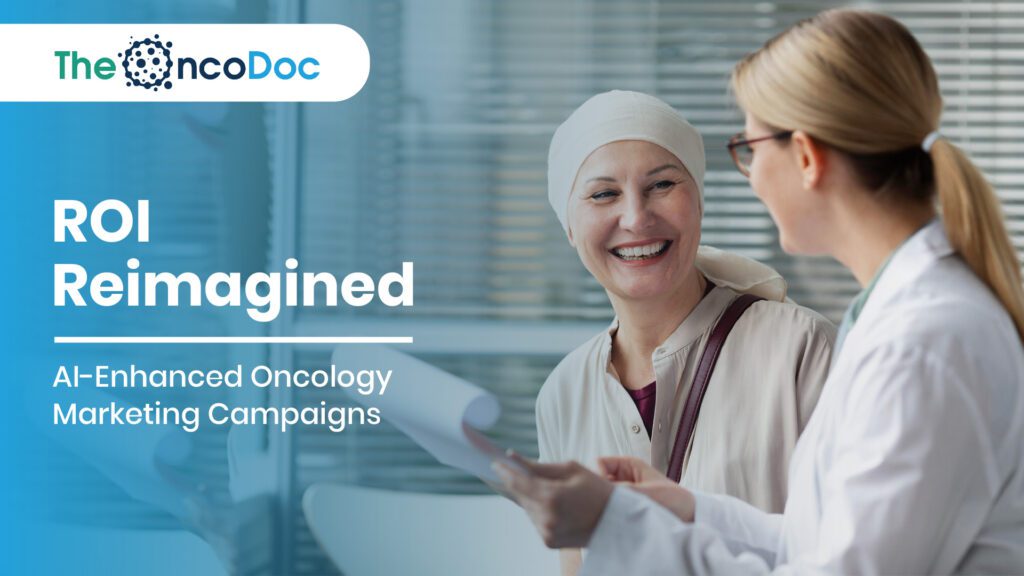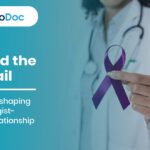Introduction: Redefining ROI in the Age of AI
Oncology marketing today stands at a decisive crossroads where success can no longer be evaluated through shallow indicators such as brand recall, digital impressions, or click-through rates. The evolving healthcare landscape demands a shift in perspective: the true return on investment (ROI) lies in how effectively campaigns contribute to meaningful outcomes, earlier cancer detection, stronger patient engagement, more efficient referral pathways, and improved long-term treatment adherence. Traditional methods fall short of capturing these multidimensional benefits, while AI enables marketers to link every strategic action to measurable impact.
Artificial intelligence introduces precision into every stage of oncology marketing, from audience segmentation and personalized storytelling to predictive alerts and real-time campaign optimization. By integrating data across patient journeys, AI provides insights that highlight both the clinical and commercial value of each investment. This shift changes the focus from cost per click to the real-world impact on lives.
This article explores how oncology pharma marketers can measure and maximize ROI in the AI era, with an emphasis on patient-centered outcomes, enhanced physician collaboration, hyper-personalized targeting, and holistic healthcare value creation that goes beyond numbers to deliver trust, equity, and measurable societal benefit.
1. ROI Beyond Traditional Metrics
In oncology marketing, ROI is not just about revenue, it’s about relevance, reach, and real-world health impact. Traditional KPIs such as ad impressions and CTRs fail to capture the value of lives impacted or screenings initiated. AI introduces a new measurement framework by linking campaign inputs to health outcomes.
Key ROI Dimensions Introduced by AI:
- Early screenings booked via AI-driven nudges.
- Reduction in diagnosis-to-treatment delays.
- Cost savings from predictive targeting versus mass marketing.
- Improved adherence due to personalized content.
2. AI-Driven Patient Journey Mapping
AI allows pharma companies to visualize the complete patient journey from symptom awareness to survivorship. By analyzing EHR data, social listening, and engagement history, marketers can see how campaigns influence decisions at each touchpoint.
ROI Impact:
- Higher conversion rates from awareness to screening.
- Timely interventions reducing late-stage cancer diagnoses.
- Retention of patients in long-term treatment programs.
3. Measuring ROI with Predictive Analytics
Predictive AI can forecast campaign outcomes before full deployment, minimizing wasted spend. By modeling different scenarios, pharma teams can optimize resource allocation.
Example ROI Outcomes:
- Predictive targeting reduced campaign cost-per-patient by 28%.
- Forecasting allowed earlier reallocation of funds from underperforming channels.
- Geo-analytics identified high-risk districts, boosting screening participation rates.
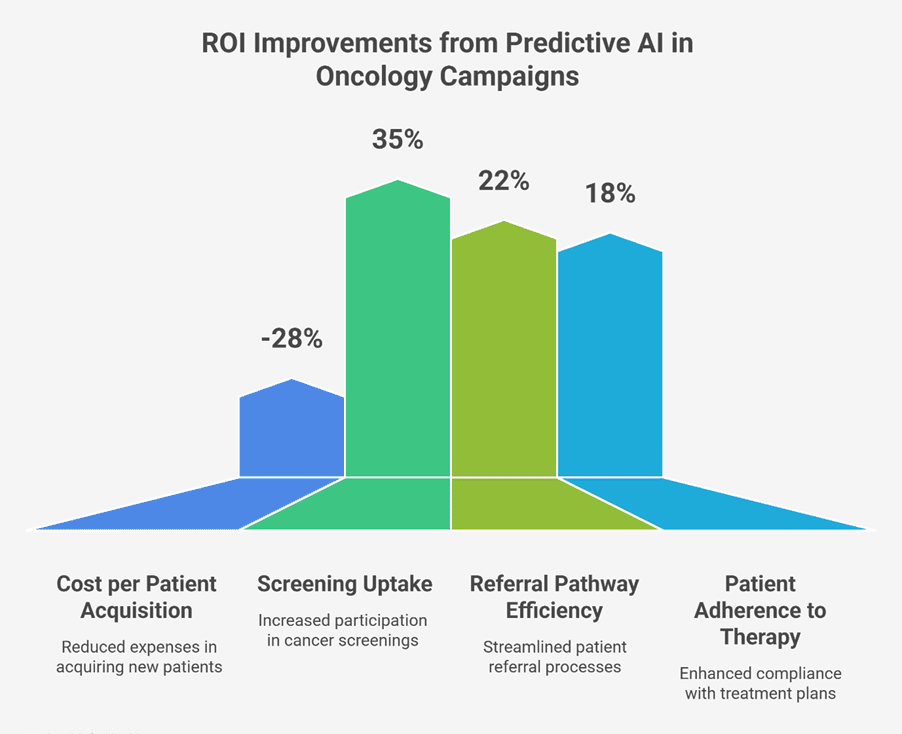
4. Cost Efficiency Through AI-Powered Segmentation
Traditional oncology campaigns often spend heavily on broad messaging. AI-driven segmentation ensures every dollar targets the right demographic, patients, caregivers, or physicians.
ROI Levers:
- Reduced wastage of marketing spend.
- Hyperlocal targeting increases engagement relevance.
- Lower acquisition cost per screened patient.
5. ROI in General Practitioner (GP) Engagement
GPs remain gatekeepers of early referrals. AI-driven learning platforms show clear ROI in keeping GPs updated.
Examples:
- AI-personalized CME modules saw 45% higher completion rates than generic ones.
- ROI measured in increased GP-to-oncologist referral conversions.
- AI chatbots for GPs saved time, reducing support costs.
6. The ROI of Omnichannel AI Campaigns
AI ensures seamless delivery across digital and offline touchpoints. ROI is seen not just in clicks but in cross-platform consistency and higher conversion ratios.
ROI Benefits:
- AI-powered campaign orchestration boosts engagement across 3+ platforms by 40%.
- Omnichannel ROI measured in improved recall and brand trust.
7. Behavioral ROI: Measuring Nudges and Triggers
AI tracks behavioral response ROI, such as the effectiveness of reminders, gamified tools, or emotional triggers.
Example ROI Gains:
- SMS nudges increased mammogram participation by 23%.
- Gamified screening challenges improved early detection ROI by reducing advanced cancer care costs.
8. Emotional Storytelling ROI with AI Support
Survivor stories remain powerful, but AI optimizes their placement and resonance. ROI can now be quantified:
- AI-placed survivor videos achieved 50% higher completion rates.
- Emotional storytelling ROI measured in screening conversions and social sharing impact.
9. ROI of AI-Personalized Content
AI ensures each patient or physician receives tailored messaging.
ROI Drivers:
- Reduced bounce rates from irrelevant campaigns.
- Higher patient trust translating into increased treatment adherence.
- Improved caregiver engagement in long-term survivorship.
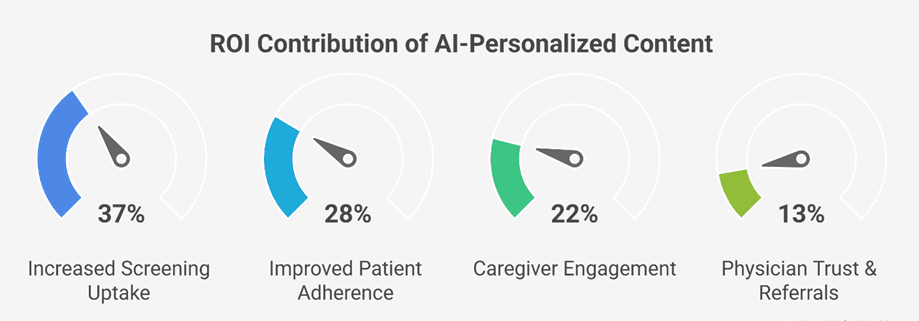
10. Vernacular and Hyperlocal ROI Gains
Campaigns in local languages consistently show higher returns.
ROI Insights:
- Vernacular campaigns improve recall rates by 42%.
- ROI measured in cost savings from reduced repeat awareness campaigns.
- Hyperlocal tailoring boosts screening-to-treatment conversion rates.
11. ROI of Oncologist-Focused AI Dashboards
When pharma brands provide oncologists with AI dashboards, ROI goes beyond marketing, it builds brand-as-partner value.
ROI Outcomes:
- Increased loyalty from oncologists.
- Better data-sharing improves treatment adherence ROI.
- Reduced cost of KOL engagement.
12. Measuring Impactful KPIs Instead of Vanity Metrics
In oncology, measurable KPIs define ROI better than impressions.
ROI KPIs include:
- % of new screenings booked.
- GP referral uptick after AI-driven CME.
- Patient engagement time with content.
- Improved diagnostic-to-treatment timelines.
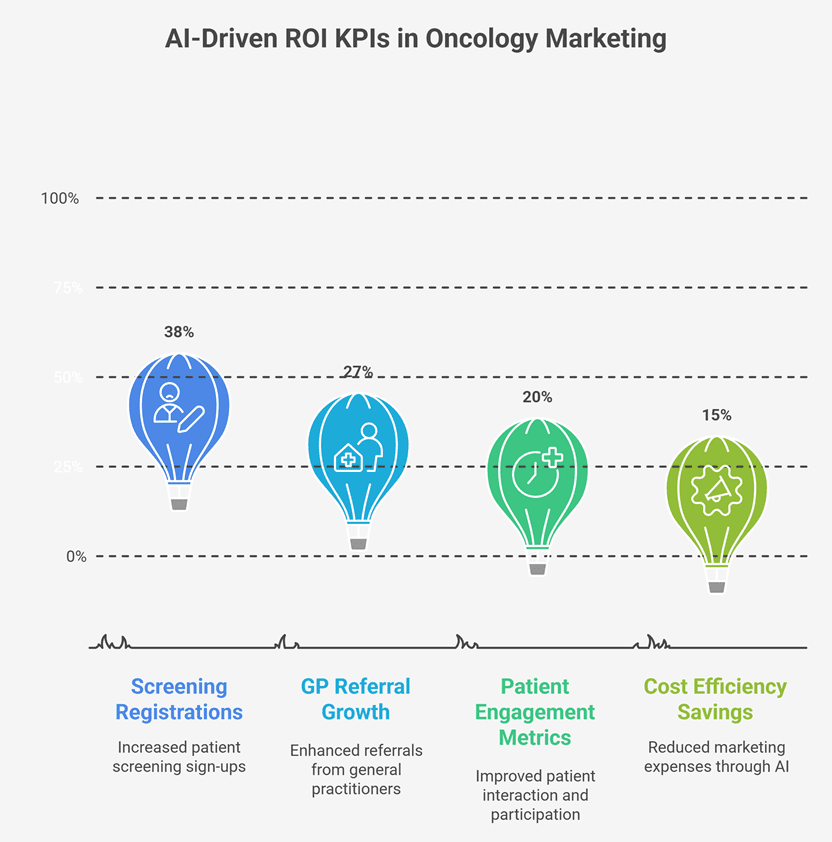
13. ROI from AI-Powered Predictive Alerts
AI-powered predictive alerts enable oncology marketers to anticipate where cancer cases may rise, allowing for proactive rather than reactive campaigns. By analyzing search patterns, regional health records, and even social conversations, predictive systems pinpoint communities at higher risk. The ROI here is not just financial, it reflects the ability to deliver timely interventions that save lives while optimizing resources. Campaigns become more cost-efficient, targeted, and impactful when executed ahead of disease surges.
Example ROI Gains:
- Outreach costs reduced by up to 30% through precise targeting instead of blanket campaigns.
- Higher conversion rates achieved in districts identified as hotspots, as interventions reach the right people at the right time.
14. Gamification ROI in Awareness Campaigns
Gamification has moved beyond being an engagement tactic to becoming a measurable ROI driver in oncology awareness campaigns. By integrating quizzes, challenges, and reward-based participation, gamification turns health education into an interactive experience that motivates action. In rural and urban settings alike, it helps overcome awareness fatigue and makes preventive behavior more appealing. The true ROI lies in both increased participation and reduced marketing costs, as patients and caregivers willingly amplify the campaign through peer influence and social sharing.
ROI Results:
- Screening camp turnout improved by 32%, leading to higher early detection rates.
- Social sharing of gamified content cut advertising expenses significantly.
- Cost per screened individual declined, proving gamification’s efficiency.
15. ROI of Wearables and Digital Health Nudges
Wearables and connected health devices are proving to be powerful, cost-effective tools in oncology marketing by nudging patients toward timely care. Smartwatches, fitness trackers, and health apps continuously monitor vitals such as weight, heart rate, and sleep patterns, allowing AI to detect anomalies and send gentle alerts. These nudges encourage early screenings, medication adherence, and lifestyle adjustments that directly impact health outcomes. From an ROI perspective, wearables reduce costs by preventing late-stage diagnoses and ensuring patients remain engaged throughout treatment. They also lessen the need for repeated awareness campaigns by building long-term self-management habits.
ROI Levers:
- Early detection lowers overall treatment expenses.
- AI-powered alerts enhance therapy adherence.
- Dropout rates from oncology regimens significantly decline.
16. ROI from Public-Private Partnerships
Public-private partnerships have emerged as high-ROI strategies in oncology marketing by combining the strengths of pharma, governments, and NGOs. These collaborations allow for shared resources, broader campaigns, and stronger credibility in communities that might otherwise distrust commercial initiatives. By co-sponsoring screening drives, training frontline workers, and aligning with public health goals, pharma companies reduce costs while amplifying reach. The ROI extends beyond finances, it builds trust, expands influence, and ensures alignment with national cancer control priorities.
ROI Impact:
- Shared costs lighten pharma’s financial load.
- Credibility boosts community trust ROI.
- Campaign reach grows 3x versus solo efforts.
17. ROI of Virtual Communities
Virtual communities powered by AI are becoming vital assets in oncology marketing, offering strong ROI through sustained engagement and trust-building. These platforms connect survivors, caregivers, and patients in supportive digital spaces where experiences, resources, and guidance are shared. Pharma brands benefit by reducing the need for costly physical support centers while still delivering high-value interactions. By fostering ongoing dialogue and providing consistent value, virtual communities strengthen patient relationships, encourage adherence, and create advocacy.
ROI Insights:
- Operational costs drop as physical support needs decline.
- Survivor retention rates improve significantly.
- Continuous engagement boosts brand loyalty ROI.
18. ROI of Voice Tech Campaigns
Voice technology is transforming oncology marketing by making it more accessible and inclusive, especially in regions with limited literacy or digital access. By leveraging AI-powered voice bots and IVR systems, campaigns can reach patients and caregivers directly in their preferred language, breaking barriers that traditional media often face.
ROI Levers:
- Reduced Campaign Costs: Voice-based campaigns are significantly more cost-efficient than video or multimedia campaigns, allowing wider reach with lower budgets.
- Enhanced Rural Penetration: Targeting rural and underserved areas increases engagement and awareness, yielding higher ROI where traditional campaigns often struggle.
- Scalable Multilingual Outreach: Voice campaigns can be adapted quickly across multiple languages, ensuring efficient scalability without proportional cost increases.
19. ROI of Sentiment Analysis for Campaign Refinement
AI-driven sentiment analysis tools provide deep insights into audience reactions, ensuring oncology campaigns resonate emotionally and avoid misalignment. These tools track patient and caregiver responses in real time, enabling marketers to refine messaging dynamically.
ROI Benefits:
- Minimized Wasted Spend: Campaigns that fail to connect are quickly identified and adjusted, reducing expenditure on ineffective content.
- Optimized Conversions: Real-time insights allow content modifications that boost engagement and conversion metrics.
- Improved Screening Participation: Messaging aligned with patient sentiment encourages higher turnout for screenings and health initiatives, maximizing overall impact.
20. Survivor Clubs as ROI Multipliers
Survivor-led initiatives in oncology marketing deliver substantial ROI by leveraging authentic patient experiences. Survivor clubs act as credible ambassadors, bridging the trust gap between pharma brands and patients or caregivers. By empowering survivors to share their journeys and insights, campaigns resonate more deeply, leading to measurable engagement and awareness outcomes.
ROI Outcomes:
- Enhanced Credibility: Peer-led campaigns naturally command greater trust, resulting in higher engagement and campaign effectiveness.
- Reduced Marketing Costs: Leveraging survivor advocacy reduces the need for costly paid promotions, making campaigns more efficient.
- Higher Participation in Workshops: Survivor endorsements drive increased turnout in early detection and educational programs, boosting the overall impact of outreach initiatives.
21. ROI in AR/VR Training Investments
Augmented and virtual reality platforms provide immersive learning experiences for oncologists while delivering strong ROI for pharma companies. AR/VR programs enhance knowledge retention, improve procedural understanding, and foster closer brand relationships.
ROI Metrics:
- Stronger Loyalty: Oncologists trained through immersive experiences develop long-term affinity for the sponsoring brand.
- Sustained Trust: Continuous educational support strengthens brand credibility in the medical community.
- Lower Training Costs: Virtual platforms reduce expenses associated with repeated in-person workshops and training sessions.
22. ROI of Smart Chatbots
AI-powered chatbots streamline patient interactions, delivering both cost savings and improved service outcomes. By automating responses to frequently asked questions and guiding patients through pre-treatment and follow-up processes, chatbots enhance efficiency and engagement.
ROI Levers:
- Support Cost Reduction: Fewer staff are required for routine inquiries, reducing operational expenses.
- 24/7 Engagement: Patients and caregivers benefit from continuous support, increasing satisfaction and loyalty.
- Efficient Patient Triage: Automated guidance ensures smoother patient management, optimizing resource allocation and improving overall care pathways.
23. ROI of Social Listening Against Misinformation
AI-led myth-busting campaigns generate ROI by protecting brand credibility.
ROI Benefits:
- Reduced patient churn due to misinformation.
- Lower costs of corrective campaigns.
- ROI measured in trust index improvements.
24. ROI of Post-Treatment Engagement
Post-treatment programs generate lifetime value ROI.
ROI Insights:
- Survivorship programs increase loyalty.
- Reduced costs of reacquisition for future therapies.
- ROI in higher patient advocacy.
25. The Future of ROI in AI-Driven Oncology Marketing
The future will see digital twins, predictive diagnostics, and real-time ROI dashboards for every campaign. ROI will increasingly be defined by how many lives are improved and how efficiently marketing dollars are spent.
Conclusion
AI is redefining how ROI is measured in oncology marketing. No longer limited to clicks and impressions, ROI now captures screenings booked, patients empowered, costs saved, and trust earned. Pharma companies that invest in AI-driven strategies not only achieve financial efficiency but also create tangible health outcomes. The winners of tomorrow will be those who prove that every marketing dollar directly contributes to earlier detection, better adherence, and longer survivorship.
The Oncodoc team is a group of passionate healthcare and marketing professionals dedicated to delivering accurate, engaging, and impactful content. With expertise across medical research, digital strategy, and clinical communication, the team focuses on empowering healthcare professionals and patients alike. Through evidence-based insights and innovative storytelling, Hidoc aims to bridge the gap between medicine and digital engagement, promoting wellness and informed decision-making.

